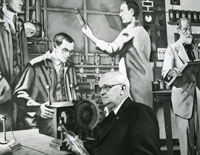
Cyril Moreau Jansky, with Malcolm Hanson, was one of the primary student contributors to the development of radio broadcasting at WHA. Whereas Hanson was engaged with testing and management of radio equipment, Jansky was a theoretical physicist who aided Earle M. Terry in the conceptual development of radio technology.
Jansky wrote that he ‘came under Terry’s influence’ as a sophomore engineering physics student in 1915 and Terry remained Jansky’s advisor until the completion of his Master’s degree in 1920. While Jansky expressed interest in staying with the university as an instructor upon the completion of his M.A., he was unable to obtain instructor status without a Ph.D. He was granted a coveted fellowship in 1918-1919 for $1000 per year to remain as Terry’s assistant, but when the fellowship ended, he moved to the University of Minnesota in 1920 to teach electrical engineering and direct their radio station 9XI, the first state-funded radio broadcasting station west of the Mississippi. He later became Associate Professor of Radio Engineering at UM, but left Minnesota for the private sector in 1929 to found Jansky and Bailey, an engineering firm.
Through his time at 9XM, Jansky became an expert at radio transmission, which led to subsequent consulting and design work. Jansky invented the use of radio waves to alert of oncoming trains as well as switch train signals—a technology implemented worldwide and still partly in use today. His M.A. thesis was written on the design and use of vacuum tubes for radiotelephony, which described not only the tubes built for the station, but the circuit used for radiotelephone broadcasting. Indeed he was pivotal in developing the design, construction, and operational characteristics of ‘element vacuum tubes’, and assisted Terry with blowing vacuum tubes from scratch, as illustrated in Terry’s biography.
When solicited by Harold McCarty to write his memories of WHA’s early practices, Jansky recollected the excitement that met Terry’s circle when they realized the possibility of radio to serve as an ‘ideal system’ for distributing news, market reports, and vital information. While he concedes that no one anticipated the full impact that radio would make in the 1920s, there was quite a bit of speculation regarding the extent to which the medium would change and improve education and other activities like weather reporting and investment.
Of further note, Jansky’s father was Dean of the College of Engineering at the University of Oklahoma at Norman and was professor of electrical engineering, and his younger brother Karl Guthe Jansky, in legacy, held the title of Professor of Electrical Engineering at the University of Wisconsin-Madison. Karl is credited with discovering the first radio waves emanating from the Milky Way, thus founding of the field of radio astronomy. An obituary written by Cyril about Karl can be found here. While no records at the Wisconsin Historical Society show a direct connection between Cyril and Karl’s possible early collaborations with radio wave experimentation, one has to wonder if the ten-year senior Cyril’s early engagements with radio had an influence upon Karl’s interest in the subject.
Jansky’s files at the Wisconsin Historical Society feature correspondence, scientific note-taking, lectures, speeches, recordings, and photos. Only some of the documents pertain to his work at WHA, but what the archive does feature paints a colorful character; he saved hundreds of letters that he wrote to various newspapers, congressmen, and other professors that cover his perspectives about everything from U.S. involvement in WWII, to political conservatism to radio physics.
Digital Documents
Related Links
